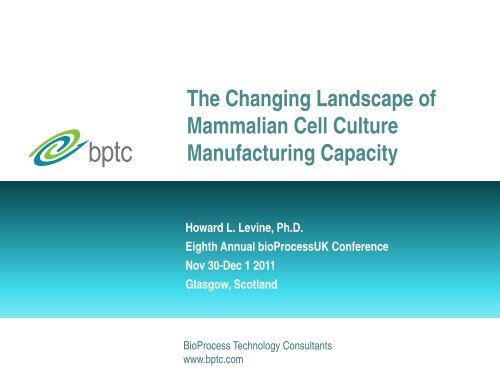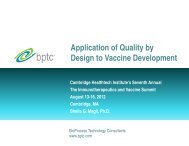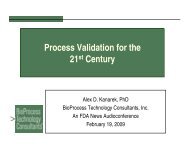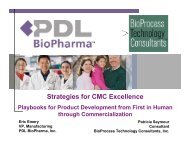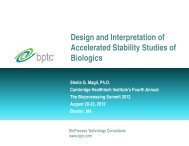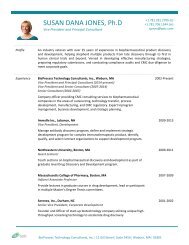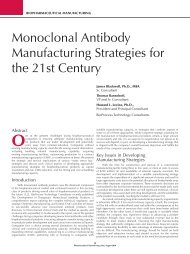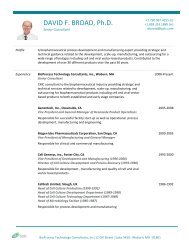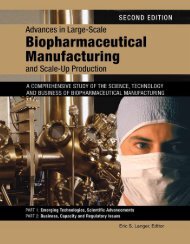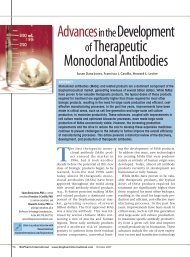The changing landscape of mammalian cell culture manufacturing ...
The changing landscape of mammalian cell culture manufacturing ...
The changing landscape of mammalian cell culture manufacturing ...
Create successful ePaper yourself
Turn your PDF publications into a flip-book with our unique Google optimized e-Paper software.
<strong>The</strong> Changing Landscape <strong>of</strong><br />
Mammalian Cell Culture<br />
Manufacturing Capacity<br />
Howard L. Levine, Ph.D.<br />
Eighth Annual bioProcessUK Conference<br />
Nov 30-Dec 1 2011<br />
Glasgow, Scotland<br />
BioProcess Technology Consultants<br />
www.bptc.com
Increasing Sales <strong>of</strong> Biopharmaceutical Products<br />
From Clone to Commercial®
US Approval <strong>of</strong> Monoclonal Antibody Products by Year<br />
6<br />
5<br />
No. Products Approved<br />
4<br />
3<br />
2<br />
1<br />
0<br />
Similar approval rates<br />
for the UK and Europe<br />
From Clone to Commercial®
Monoclonal Antibodies Drive Biopharmaceutical Revenue<br />
Average Revenue, US$ million<br />
Ref: Datamonitor, company‐related information<br />
From Clone to Commercial®
Top Ten Selling Biopharmaceutical Products<br />
US<br />
Product Name<br />
Company<br />
2010 Sales<br />
(Billions USD)<br />
Remicade J&J/Merck 7.324<br />
Enbrel Amgen/Pfizer 6.808<br />
Humira Abbott 6.500<br />
Avastin Roche 6.201<br />
‣ Sales <strong>of</strong> almost $50 billion<br />
‣ 8 out <strong>of</strong> 10 are produced in<br />
<strong>mammalian</strong> <strong>cell</strong> <strong>culture</strong><br />
‣ 7 out <strong>of</strong> 10 are monoclonal<br />
antibody‐related products<br />
‣ CAGR for monoclonal antibodyrelated<br />
products from 2001‐2010<br />
was >40%<br />
Rituxan Roche 6.100<br />
Lantus San<strong>of</strong>i‐Aventis 5.699<br />
Herceptin Roche 5.211<br />
Neulasta Amgen 3.558<br />
Novolog Novo Nordisk 3.512<br />
Lucentis Roche/Novartis 2.899<br />
From Clone to Commercial®
Product Demand Greatest for Monoclonal Antibodies<br />
Demand for existing commercial antibody<br />
products will nearly double by 2016<br />
‣ ~8.3 metric ton ~13.4 metric tons<br />
(2010) (2016)<br />
Product Demand for<br />
Commercial Antibody Products<br />
‣ 2010 requirements for each <strong>of</strong> the top five<br />
monoclonal antibody products ranged from<br />
1.0 –2.3 metric ton<br />
All others<br />
(27)<br />
26%<br />
Remicade<br />
17%<br />
‣ 2010 demand for all other monoclonal<br />
antibody products combined was<br />
approximately 2.5 metric tons<br />
‣ Anticipated demand for new monoclonal<br />
antibody products approved between now<br />
and 2016 is expected to be
Demand for Bio<strong>manufacturing</strong> Capacity Growing<br />
‣ Driven by growing market for approved products, large number <strong>of</strong> products in<br />
clinical development, and growing interest in biosimilars<br />
‣ Volumetric requirements will almost double by 2016, leaving companies and<br />
markets without capacity scrambling for resources<br />
From Clone to Commercial®
Distribution <strong>of</strong> Mammalian Cell Culture Capacity<br />
Greatest increase<br />
in number <strong>of</strong><br />
companies with<br />
clinical capacity<br />
From Clone to Commercial®
Geographic Distribution <strong>of</strong> Cell Culture Capacity<br />
Region<br />
North<br />
America<br />
2010 2016<br />
Volume in<br />
‘000s L<br />
1,661 2,181<br />
UK/Ireland 183 281<br />
Europe 712 1,125<br />
Korea 51 213<br />
Japan 100 125<br />
China
Balance <strong>of</strong> Supply and Demand<br />
Assumes no<br />
increase in<br />
current titers<br />
Capacity utilization to increase from 43% to 64% in next five years<br />
Perfusion capacity adjusted to equivalent<br />
fed‐batch capacity where appropriate<br />
From Clone to Commercial®
Product Companies Control ~70% <strong>of</strong> Capacity<br />
4,500<br />
3,600<br />
Installed Capacity<br />
2,700<br />
1,800<br />
900<br />
0<br />
2010 2011 2012 2013 2014 2015 2016<br />
CMO XS Product Co.<br />
Perfusion capacity adjusted to equivalent<br />
fed‐batch capacity where appropriate<br />
From Clone to Commercial®
Ten Companies Control >75% <strong>of</strong> Capacity<br />
2010<br />
Rank<br />
2016<br />
Rank<br />
Company<br />
2010 Volume<br />
(1,000s L)<br />
2016 Volume<br />
(1,000s L)<br />
1 1 Roche 525 600<br />
2 4 J&J 230 230<br />
3 5 Boehringer Ingelheim 216 216<br />
4 6 Amgen 198 198<br />
5 3 Lonza 150 232<br />
6 8 Pfizer 139 149<br />
7 2 San<strong>of</strong>i‐Aventis 133 263<br />
8 ‐ Novartis 125 ‐<br />
9 10 Lilly 122 137<br />
10 7 Biogen Idec 106 196<br />
‐ 9 Celltrion ‐ 140<br />
All Others 614 1,070<br />
TOTAL 2,558 3,431<br />
Perfusion capacity adjusted to equivalent<br />
fed‐batch capacity where appropriate<br />
From Clone to Commercial®
Utilization at Top 5 Product Companies ~50%<br />
Includes Roche,<br />
J&J, Amgen, Pfizer,<br />
San<strong>of</strong>i‐Aventis<br />
Perfusion capacity adjusted to equivalent<br />
fed‐batch capacity where appropriate<br />
From Clone to Commercial®
Utilization Pushes 75% for the Rest <strong>of</strong> the Industry<br />
45% 45% 45% 45% 45% 45%<br />
Perfusion capacity adjusted to equivalent<br />
fed‐batch capacity where appropriate<br />
From Clone to Commercial®
Bio<strong>manufacturing</strong> Capacity Adequate but Tightening<br />
Increase in number <strong>of</strong> products and expanding markets<br />
will increase demand by ~1 million liters by 2016<br />
• Current and anticipated supply <strong>of</strong> capacity is<br />
sufficient to meet the market needs for the<br />
foreseeable future<br />
Existing capacity may not be available or appropriate<br />
• Product companies control >70% <strong>of</strong> total capacity<br />
• Utilization rates for the majority <strong>of</strong> the industry will<br />
reach almost 75% by 2016<br />
Companies without <strong>manufacturing</strong> capacity or secure<br />
<strong>manufacturing</strong> contracts may experience difficulties in<br />
accessing capacity in the coming years<br />
From Clone to Commercial®
Trends Influencing Future Capacity Requirements<br />
Higher yielding<br />
processes<br />
Biosimilars<br />
New Product Types<br />
‣ Today’s bioreactors will<br />
produce more product<br />
per batch<br />
‣ Existing markets –<br />
spread capacity<br />
demand among more<br />
players<br />
‣ New markets –<br />
potential increase in<br />
demand<br />
‣ Shift away from full<br />
length, naked<br />
monoclonal antibodies<br />
to other scaffolds or<br />
more potent products<br />
may alter demand<br />
From Clone to Commercial®
Modern, State-<strong>of</strong>-the art Processes<br />
‣ Cell <strong>culture</strong> titers <strong>of</strong> titer >5 g/L imply smaller bioreactors producing similar<br />
quantities to today’s “six pack” facilities<br />
‣ Multi‐product capabilities and flexibility will become increasingly important<br />
‣ Disposable technologies will become increasingly prevalent<br />
‣ Continuous processing, PAT and other modern <strong>manufacturing</strong> methods will be<br />
incorporated into bioprocessing<br />
Photos courtesy <strong>of</strong> Pall Life Sciences and Sartorius Stedim<br />
From Clone to Commercial®
Biologic Products – Current and Future<br />
‣ New MAbs, F c ‐fusion proteins, F ab ,<br />
Antibody‐Drug Conjugates, alternate<br />
scaffolds<br />
‣ Smaller niche markets that current<br />
products<br />
‣ Biosimilar products currently approved in<br />
Europe<br />
‣ Many Mabs will be <strong>of</strong>f patent in next few years<br />
• Some already available in India and China<br />
Adapted from Stout, J. BPI Conference 2011<br />
From Clone to Commercial®
Many Biosimilars in Development Worldwide<br />
Already Approved<br />
Abseamed<br />
Binocrit<br />
Epoetin alfa Hexal<br />
Biograstim<br />
Filgrastim Hexal<br />
Filgrastim Ratiopharm<br />
Nivestim<br />
Ratiograstim<br />
Tevagrastim<br />
Zarzio<br />
Omnitrope<br />
Valtropin<br />
Retacrit<br />
Silapo<br />
MAbs Soon To Be Off Patent<br />
Avastin<br />
Enbrel<br />
Erbitux<br />
Herceptin<br />
Humira<br />
Lucentis<br />
Remicade<br />
Rituxan<br />
Ref:<br />
http://www.gabionline.net/Biosimilars/General/Biosimilars‐approvedin‐Europe<br />
and http://www.gabionline.net/Reports/Top‐25‐biotechdrugs‐the‐next‐biosimilars‐targets<br />
From Clone to Commercial®
Interest in Antibody-Drug Conjugates is Growing<br />
Are more ADCs entering and<br />
moving through the pipeline<br />
compared to 5 years ago<br />
How important a class <strong>of</strong><br />
compounds do you expect<br />
ADCs to become<br />
bioPULSE<br />
From Clone to Commercial®
Impact <strong>of</strong> Antibody-Drug Conjugates on Demand<br />
What impact will ADCs<br />
have on the demand for<br />
<strong>cell</strong> <strong>culture</strong> capacity<br />
‣ Responses equally split between increasing demand for<br />
capacity or no impact on future capacity requirements<br />
‣ Although doses <strong>of</strong> ADCs will be lower than unconjugated<br />
monoclonal antibodies, no responses that ADCs would lower<br />
demand for <strong>cell</strong> <strong>culture</strong> capacity<br />
bioPULSE<br />
From Clone to Commercial®
Analysis <strong>of</strong> Bio<strong>manufacturing</strong> Capacity<br />
‣ Comprehensive in‐depth analysis <strong>of</strong> the<br />
biopharmaceutical market and the<br />
impact <strong>of</strong> current trends on the supply<br />
and demand for <strong>mammalian</strong> <strong>cell</strong> <strong>culture</strong><br />
<strong>manufacturing</strong> capacity through 2016<br />
‣ Provides detailed information on<br />
<strong>manufacturing</strong> capacity world‐wide<br />
• Analysis <strong>of</strong> market trends<br />
• Projections for capacity utilization<br />
• Impact <strong>of</strong> disposables, and biosimilars,<br />
and more<br />
‣ To order visit www.bptc.com/reports.php<br />
From Clone to Commercial®
Thank You!<br />
Howard L. Levine, Ph.D.<br />
hlevine@bptc.com<br />
+1.781.281.2703<br />
BioProcess Technology Consultants, Inc.<br />
12 Gill Street, Suite 5450<br />
Woburn, MA 01801


